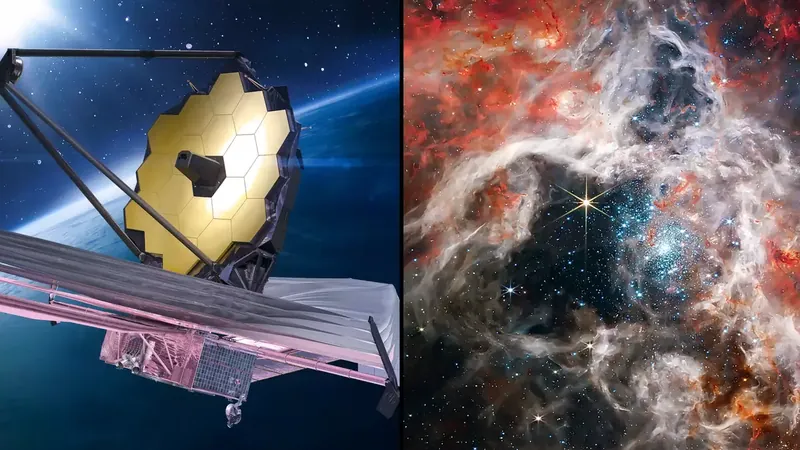
James Webb Telescope Unveils Startling Secrets of the Universe, Challenging Our Understanding of Reality!
2024-09-28
In a groundbreaking revelation, the James Webb Space Telescope (JWST) has made a discovery that could profoundly reshape our understanding of the universe as we know it.
The JWST, launched in December 2021, is a more sophisticated successor to the iconic Hubble Space Telescope. It has been making waves in the astronomical community with its unparalleled ability to capture breathtaking high-resolution images of celestial bodies, including vibrant galaxies, nascent stars, and enigmatic early-stage black holes.
However, amidst its remarkable discoveries, one particular finding has sent shockwaves through physicist circles, leading to what some experts are describing as a "crisis" in our comprehension of cosmic principles.
What is the Hubble Tension?
At the core of the controversy lies the "Hubble Tension." This phenomenon represents the discrepancy between two distinct methods used to calculate the universe's expansion rate, known scientifically as the Hubble constant. As it stands, different measurements lead to conflicting estimates regarding how quickly our universe is stretching.
There are two principal methods for determining this cosmic speedometer. The first relies on the remnants of the Big Bang, specifically analyzing tiny variations in the cosmic microwave background radiation. Astronomers who studied this between 2009 and 2013 estimated the expansion rate to be around 67 kilometers per second per megaparsec (km/s/Mpc).
The second approach utilizes pulsating stars, particularly Cepheid variables. These stars flicker in a predictable manner, allowing astronomers to create a "cosmic distance ladder" to measure distances and calculate the expansion rate. Using this method, Adam Riess, a professor at Johns Hopkins University, and his team concluded that the true rate might actually be approximately 74 km/s/Mpc—significantly higher than the earlier figure.
The Implications Are Astounding
This apparent contradiction implies that the universe could be up to 10 percent younger than previously estimated, raising alarm bells within the cosmology community. Nobel laureate David Gross has labeled the situation a "crisis," underscoring the urgency of reconciling these conflicting views.
So, what did the JWST discover that could unravel our longstanding theories? Initially, the extraordinary findings were dismissed as mere measurement errors, stemming from confounding Cepheid stars with ordinary stars in Hubble's observations. However, the JWST's precision has validated the higher rates of expansion, leading to a seismic shift in our cosmic narrative.
On February 6, a landmark study published in the *Astrophysical Journal Letters* reasserted the possibility that our understanding of the universe is fundamentally flawed. Professor Riess, who led the study, emphasized, "With measurement errors ruled out, we now face an exhilarating prospect: we may have fatally misunderstood the cosmos."
His team scrutinized around 1,000 Cepheid stars across five remote galaxies—some as far as 130 million light-years away—confirming their initial hypotheses regarding the Hubble constant. “We’ve comprehensively covered the full spectrum of Hubble's observations to eliminate any doubt regarding measurement inaccuracies,” Riess elaborated.
What Lies Ahead?
As the JWST continues to gather and analyze cosmic data, we stand at the brink of astronomical revelation. The implications of this research could trigger a renaissance in cosmological studies, forcing astronomers to reevaluate essential truths about the universe's nature and origins.
This exploration may finally unveil secrets that have eluded us for centuries, perhaps pushing humanity closer to understanding our place in an ever-expanding cosmos. Are we on the verge of discovering more about the universe—and ourselves—than ever before? Only time will tell!




 Brasil (PT)
Brasil (PT)
 Canada (EN)
Canada (EN)
 Chile (ES)
Chile (ES)
 España (ES)
España (ES)
 France (FR)
France (FR)
 Hong Kong (EN)
Hong Kong (EN)
 Italia (IT)
Italia (IT)
 日本 (JA)
日本 (JA)
 Magyarország (HU)
Magyarország (HU)
 Norge (NO)
Norge (NO)
 Polska (PL)
Polska (PL)
 Schweiz (DE)
Schweiz (DE)
 Singapore (EN)
Singapore (EN)
 Sverige (SV)
Sverige (SV)
 Suomi (FI)
Suomi (FI)
 Türkiye (TR)
Türkiye (TR)